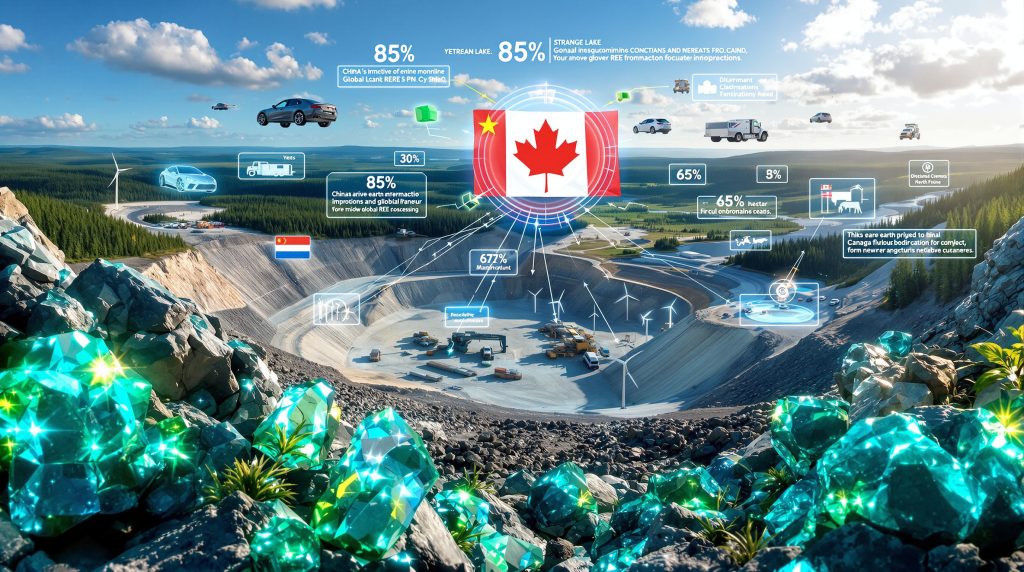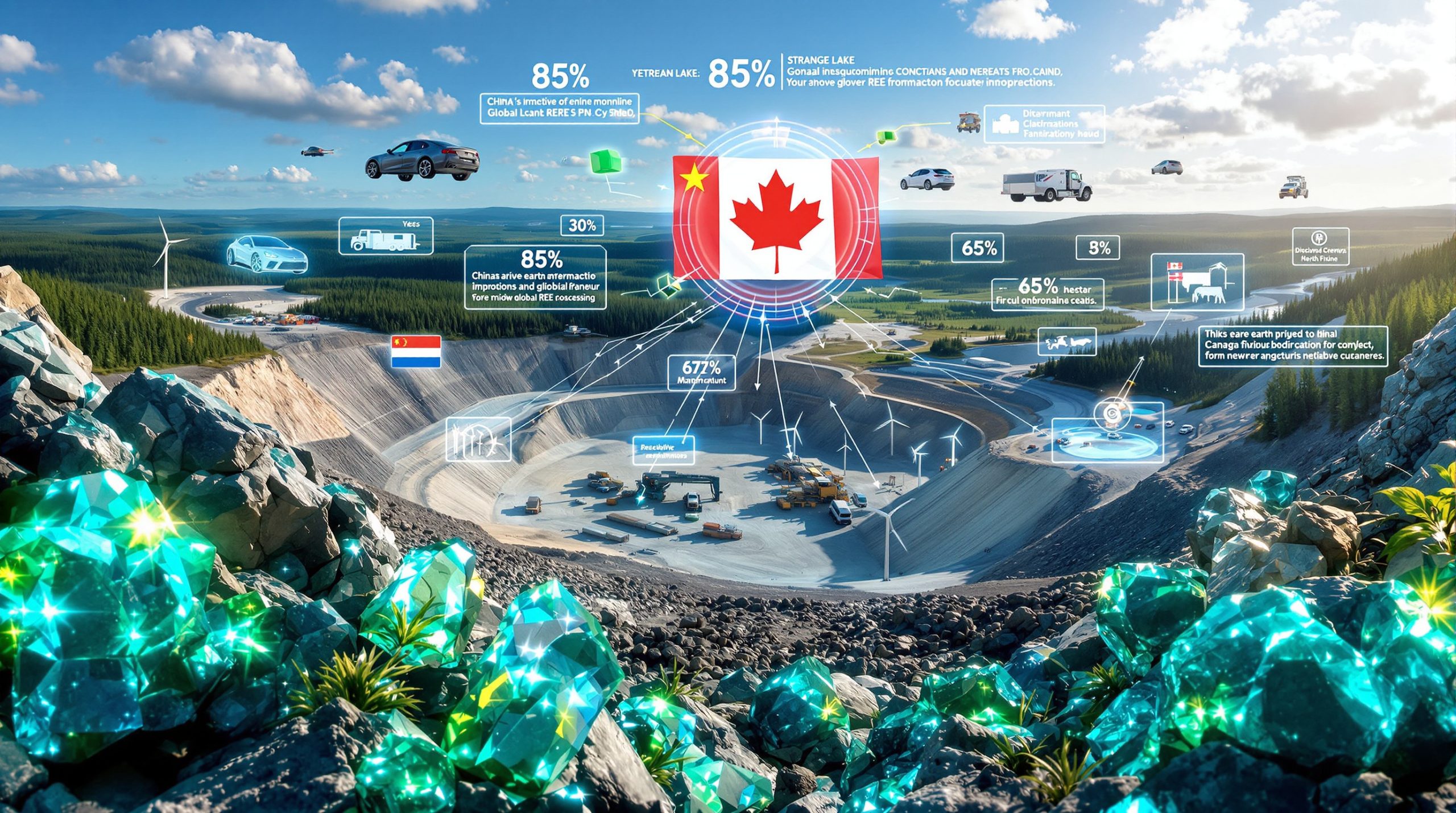What is the Strange Lake Project?
The Strange Lake mine and concentrator project represents one of North America's most significant rare earth element (REE) developments, strategically positioned near Lac Brisson in Nunavik, northern Quebec. Led by Quebec-based Torngat Metals, this ambitious venture aims to establish a sustainable supply chain for critical minerals energy transition essential to the global clean energy transition.
The project's unique geological formation contains exceptional concentrations of both light and heavy rare earth elements, with particular abundance of dysprosium and terbium—two elements crucial for manufacturing permanent magnets used in electric vehicles, wind turbines, and defense technologies.
According to data from Mining Weekly (September 2025), the project will extract between 5-13 million tonnes of material quarterly throughout its 30+ year operational lifespan, making it a cornerstone of North American mineral security for decades to come.
Why Are Rare Earth Elements So Important?
Critical Components for Green Technology
Rare earth elements, despite their name, are relatively abundant in the Earth's crust but rarely found in concentrations that make extraction economically viable. Their unique magnetic, luminescent, and electrochemical properties make them irreplaceable in numerous high-tech applications:
-
Permanent magnets: Essential for electric vehicle motors and wind turbine generators
-
Catalytic converters: Reducing emissions in vehicles
-
Polishing compounds: Used in precision optical equipment
-
Phosphors: Creating colors in displays and lighting
-
Defense technologies: Critical components in guidance systems and radar
Heavy rare earths like dysprosium and terbium are particularly valuable due to their scarcity and crucial role in enhancing the temperature resistance of permanent magnets—a property essential for electric vehicle motors and wind turbines.
Global Supply Chain Vulnerabilities
Currently, China dominates the global rare earth supply chain, controlling approximately 85% of processing capacity. This concentration creates significant vulnerabilities for Western economies transitioning to clean energy technologies:
| Region | Global REE Processing Share |
|---|---|
| China | ~85% |
| Rest of World | ~15% |
The Strange Lake project represents a strategic opportunity to diversify supply chains and reduce dependency on a single geographic source for these critical minerals. Natural Resources Canada has identified rare earth elements as priority materials in the country's strategic minerals reserve, highlighting their importance for economic and national security.
Project Scale and Development Timeline
Mine Specifications and Output
The Strange Lake project encompasses a comprehensive mining and processing operation designed for long-term production:
-
Mine type: Open-pit
-
Expected material extraction: 5-13 million tonnes quarterly
-
Projected mine life: 30+ years
-
Annual rare earth mixture production: ~15,000 tonnes
-
Primary products: Dysprosium, terbium, and other heavy/light rare earths
The scale of the project positions it to become a significant global producer of heavy rare earth elements, particularly dysprosium and terbium, which are critical for high-performance magnets used in clean energy applications.
Development Schedule
Torngat Metals has established a clear timeline for bringing the project online:
-
2025: Completion of prefeasibility and feasibility studies
-
2026-2027: Construction phase
-
2028: Target production start
-
2028-2058+: Operational phase
This timeline aligns with growing global demand projections for rare earth elements, with market analysts forecasting a significant supply gap for heavy rare earths by the early 2030s if new production sources aren't developed.
How Will the Project Operate?
Mining and Concentration Process
The Strange Lake operation will implement a two-stage processing approach to maximize efficiency and minimize environmental impact:
-
On-site concentration: The mine site will house a primary concentration facility to reduce the volume of material requiring transportation
-
Separation facility: A state-of-the-art separation plant in Sept-Îles will process the concentrate to isolate individual rare earth elements
This approach optimizes logistics while ensuring the highest value processing occurs within Quebec, maximizing economic benefits for the region. The separation facility represents a particularly strategic investment, as separation capacity outside of China remains limited globally.
Infrastructure Development
The project requires significant infrastructure investment:
-
Transportation network: Development of access routes for concentrate transport
-
Power systems: Renewable energy integration where feasible
-
Water management: Comprehensive systems for responsible water use and treatment
-
Staff accommodation: Facilities for the operational workforce
Given the remote location near Lac Brisson in Nunavik, infrastructure development represents one of the project's most significant challenges and investment requirements. The transportation logistics between the mine site and the separation facility in Sept-Îles will be critical to the project's economic viability.
What Economic Benefits Will Strange Lake Deliver?
Job Creation and Community Impact
The project represents a significant economic opportunity for Quebec and Labrador:
-
Construction phase: Approximately 1,000 jobs
-
Operational phase: Around 130 permanent positions
-
Indigenous recruitment: Focused hiring initiatives for communities in Quebec and Labrador
-
Supply chain development: Opportunities for local businesses to provide goods and services
Beyond direct employment, the project will create numerous indirect jobs throughout the supply chain, from transportation and logistics to equipment maintenance and service providers.
Strategic Economic Positioning
Beyond direct employment, Strange Lake positions Canada as a key player in the critical minerals supply chain:
-
Value-added processing: Developing domestic capacity for rare earth separation
-
Technology development: Opportunity to advance mining technology innovation
-
Export potential: Supplying processed rare earths to global markets
The development of domestic rare earth separation capacity is particularly significant, as this high-value part of the supply chain has historically been dominated by China. Building this capability within Canada creates both economic opportunities and supply chain resilience.
How is the Project Being Financed?
Current Funding Structure
Torngat Metals has secured significant financial backing to advance the project:
-
Export Development Canada: C$110 million bridge loan facility
-
Canada Infrastructure Bank: Commitment of up to C$55 million
-
Additional funding: Being pursued for full project development
This financial support demonstrates strong government recognition of the project's strategic importance to Canada's critical minerals strategy. The involvement of the Canada Infrastructure Bank highlights how the project aligns with national infrastructure priorities related to economic development and resource security.
Future Funding Requirements
While initial financing has been secured for prefeasibility and feasibility studies, full project development will require substantially more capital investment. Mining industry analysts estimate that rare earth projects typically require significant capital expenditure per tonne of annual production capacity, reflecting the complex processing requirements.
Potential sources for additional funding include:
-
Strategic industry partnerships with end-users of rare earth products
-
International investment from countries seeking supply chain diversification
-
Traditional project finance from commercial lenders
-
Expanded government support through various programs
What Environmental Considerations Are Being Addressed?
Sustainable Development Approach
The Strange Lake project is being developed with environmental sustainability as a core principle:
-
Water management: Comprehensive systems to protect local watersheds
-
Energy efficiency: Optimizing processes to minimize mining decarbonisation benefits
-
Land reclamation: Progressive mine reclamation innovation planning throughout mine life
-
Biodiversity protection: Measures to minimize impact on local ecosystems
Unlike some historical mining operations, modern rare earth projects like Strange Lake incorporate environmental considerations from the earliest stages of planning and design.
Regulatory Compliance and Community Engagement
The project is subject to rigorous environmental assessment processes:
-
Federal and provincial reviews: Comprehensive regulatory oversight
-
Indigenous consultation: Ongoing engagement with affected communities
-
Transparency commitments: Regular reporting on environmental performance
The project must navigate complex regulatory requirements at both the federal and provincial levels, including the Canadian Environmental Assessment Act and Quebec's Environment Quality Act.
What Makes Strange Lake Globally Significant?
Strategic Resource Position
The Strange Lake deposit stands out globally for several key reasons:
-
Exceptional heavy rare earth content: Particularly rich in dysprosium and terbium
-
Scale of resource: Potential to be North America's largest heavy rare earth producer
-
Processing innovation: Opportunity to develop advanced separation technologies
-
Supply chain security: Reducing Western dependence on Chinese rare earth processing
The project's focus on heavy rare earths like dysprosium and terbium is particularly significant, as these elements face more severe supply constraints than light rare earths but are essential for high-performance permanent magnets.
Comparison to Global Producers
When operational, Strange Lake will represent a significant addition to global rare earth supply:
| Project | Primary REE Focus | Annual Production Capacity |
|---|---|---|
| Strange Lake (Canada) | Heavy REEs | ~15,000 tonnes REE mixture |
| Mountain Pass (USA) | Light REEs | ~43,000 tonnes REO |
| Mount Weld (Australia) | Light REEs | ~20,000 tonnes REO |
This comparison highlights Strange Lake's strategic importance as a source of heavy rare earths, which are currently in shorter supply globally than light rare earths.
What Challenges Must Be Overcome?
Technical Complexities
Rare earth projects face unique technical challenges:
-
Mineralogy complexity: Rare earth elements typically occur together and require sophisticated separation
-
Processing technology: Advanced methods needed for efficient extraction and separation
-
Infrastructure development: Remote location requires significant investment
The separation of individual rare earth elements is particularly challenging, requiring multiple stages of chemical processing. Developing efficient, environmentally responsible separation technology represents both a challenge and an opportunity for innovation.
Market Dynamics
The rare earth market presents specific challenges:
-
Price volatility: Historical fluctuations in rare earth prices
-
Market concentration: Need to develop alternative supply chains to China
-
End-user development: Building relationships with manufacturers who require rare earth products
Price volatility has been a significant challenge for rare earth producers historically, with dramatic price swings occurring in 2011-2012 and again in 2017. Establishing long-term offtake agreements with end-users can help mitigate this risk.
Future Outlook for Strange Lake
Potential for Expansion
The Strange Lake project has significant potential for future growth:
-
Resource expansion: Further exploration may increase the known resource
-
Processing advancements: Technological improvements could enhance recovery rates
-
Product diversification: Potential to extract additional elements from the deposit
As initial operations prove successful, there may be opportunities to expand production capacity or develop more advanced processing capabilities to capture additional value from the resource.
Strategic Importance
As global demand for clean energy technologies accelerates, Strange Lake's strategic importance will likely increase:
-
Electric vehicle growth: Projected to drive increased demand for rare earth magnets
-
Wind energy expansion: Another key driver of rare earth demand
-
Supply chain resilience: Growing recognition of the need for diverse supply sources
Industry analysts project that demand for rare earth magnets could grow at a compound annual rate of 7-10% through 2030, driven primarily by electric vehicles and wind turbines.
Conclusion
The Strange Lake mine and concentrator project represents a transformative opportunity for Canada's critical minerals sector. With its exceptional resource quality, strategic location, and comprehensive development approach, the project is positioned to become a cornerstone of North American rare earth supply.
As Torngat Metals advances through feasibility studies toward production, Strange Lake stands to make a significant contribution to both regional economic development and global supply chain security for materials essential to the clean energy transition.
The project exemplifies how Canada is leveraging its mineral resources to play a crucial role in the global transition to clean energy technologies while creating domestic economic opportunities and enhancing national security through supply chain diversification.
Ready to Profit from the Next Major Mineral Discovery?
Discover how significant ASX mineral discoveries can generate substantial returns for investors by exploring Discovery Alert's dedicated discoveries page, where our proprietary Discovery IQ model transforms complex mineral data into actionable investment insights for both new and experienced investors.




